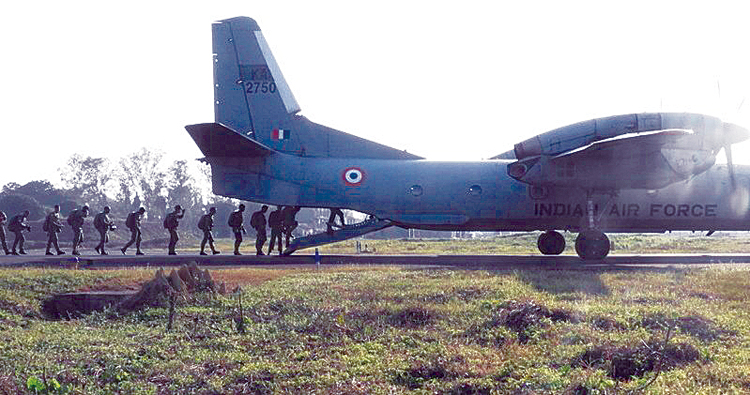INDIAN ARMED FORCES CHIEFS ON OUR RELENTLESS AND FOCUSED PUBLISHING EFFORTS

The insightful articles, inspiring narrations and analytical perspectives presented by the Editorial Team, establish an alluring connect with the reader. My compliments and best wishes to SP Guide Publications.

"Over the past 60 years, the growth of SP Guide Publications has mirrored the rising stature of Indian Navy. Its well-researched and informative magazines on Defence and Aerospace sector have served to shape an educated opinion of our military personnel, policy makers and the public alike. I wish SP's Publication team continued success, fair winds and following seas in all future endeavour!"

Since, its inception in 1964, SP Guide Publications has consistently demonstrated commitment to high-quality journalism in the aerospace and defence sectors, earning a well-deserved reputation as Asia's largest media house in this domain. I wish SP Guide Publications continued success in its pursuit of excellence.
- Appointments Committee of Cabinet approves one-month extension in service of Chief of the Army Staff
- Prime Minister witnesses 'Bharat Shakti' – a Tri-Services Firing and Manoeuvre Exercise in Pokhran, Rajasthan
- Interim Defence Budget 2024-25 — An Analysis
- Union Defence budget 2024
- Indian Army: In quest of greater firepower and policy recommendations for gaps
- Indian Army Annual Press Conference 2024
- Tata Boeing Aerospace Delivers 250 AH-64 Apache Fuselages, Manufactured in India
Airborne Exercises Along Northern Borders
Amid the heightened tensions with China, along the Line of Actual Control (LAC), the Indian Army conducted airborne exercises to validate rapid response capabilities and seamless integration

The continuing confrontation with China requires our military to keep honing its skills and be prepared for any eventuality. With the US-led West targeting Russia and having similar designs against China, this is an ideal time for Beijing to resolve its border issues with India through mutual agreement with irrevocable guarantees.
Amid the heightened tensions with China, along the LAC , the Indian Army conducted airborne exercises in November 2021, to carry out airborne insertion in Eastern Ladakh at 14,000 feet. Fully acclimatised troops with specialist vehicles and missile detachments were transported through C-130 and AN-32 aircraft from five different mounting bases to validate inter-theatre move, precision standoff drops, rapid grouping and the capture of designated objectives with speed and surprise. The exercise also involved combat jumps and integrated battle drills by airborne forces, mechanised columns and attack helicopters, to validate rapid response capabilities and seamless integration.
Another exercise was carried out collectively by the Indian Air Force and mechanised forces of the Indian Army, which entailed parachute drops of paratroopers, combat loads, vehicle mounted-anti tank and air defence missile detachments, over a designated target area from C-130 and AN-32 aircraft. Earlier in October 2019, the Army had conducted Exercise ‘Him Vijay’ to test its new warfighting concept of Integrated Battle Groups (IBG) in mountain warfare under the 17 Mountain Corps in Arunachal Pradesh, which has an offensive role.
In January 2020, Indian Army had conducted Exercise, ‘Winged Raider’ - a large airborne exercise in the North-Eastern theatre, involving parachuting by over 500 troops, possibly battalion group, from the C-130 Hercules and C-17 Globemaster transport aircraft of the Indian Air Force (IAF) as also using the Army’s Dhruv helicopters during the day and night exercise. The Army later said, “Exercise Winged Raider demonstrated the operational readiness of our Paratroopers and Air Warriors to undertake airborne missions.”
Again on March 25, 2022, the Indian Army conducted airborne exercises reportedly in the Siliguri Corridor to test capabilities along our northern borders and to validate aerial insertion and rapid response entailed airlifting of airborne troops, large scale drops, rapid regrouping, and surveillance of critical targets and capture of objectives. China’s continued belligerence has shifted major focus towards our border with China. This includes upgrading and building roads in the forward areas, habitats, storage for ammunition and moving some of the advanced weapons systems towards the eastern side.
A cross section believes that future war with China will be hybrid, with China launching massive cyber attacks to target our critical infrastructure, command and control centres, with little scope for conventional warfare. This view is more with the ongoing conflict in Ukraine where the US and allies have pumped in thousands of well armed mercenaries to fight the Russian forces.
However, hybrid warfare entails interplay of conventional as well as unconventional instruments of power and tools of subversion, which are blended in a synchronised manner to exploit the vulnerabilities of an adversary and achieve synergistic effects. Therefore, conventional operations and airborne exercises will continue to play an important role within the gamut of hybrid warfare.





